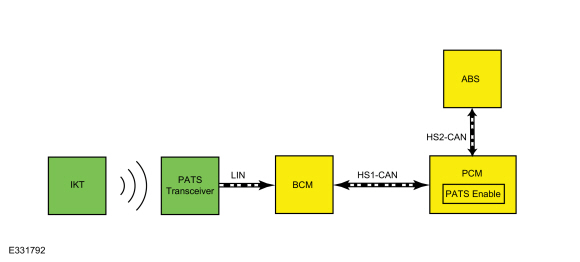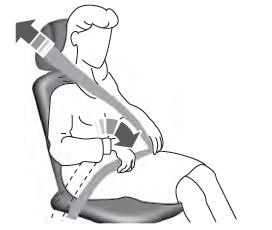Ford Escape: Passive Anti-Theft System (PATS) / Description and Operation - Passive Anti-Theft System (PATS) - System Operation and Component Description
System Operation
System Diagram

| Item | Description |
|---|---|
| 1 | PCM |
| 2 | BCM |
| 3 | IKT |
| 4 | PATS Enable |
| 5 | PATS Transceiver |
| 6 | ABS |
Network Message Chart
Module Network Input Messages - BCM
| Broadcast Message | Originating Module | Message Purpose |
|---|---|---|
| PATS start request target data | PCM | The PCM sends the BCM and the ABS module a challenge request for a valid ID. |
Module Network Input Messages - PCM
| Broadcast Message | Originating Module | Message Purpose |
|---|---|---|
| PATS control command | BCM | The response from the BCM supplying the PCM challenge ID. If the BCM ID response is incorrect, then PATS prevents the vehicle from starting. |
Module Network Input Messages - ABS Module
| Broadcast Message | Originating Module | Message Purpose |
|---|---|---|
| Immobilizer target 1 function | PCM | The immobilizer subtarget function sends a responce message to challenge message from the PCM . |
Module Network Input Messages - ABS Module
| Broadcast Message | Originating Module | Message Purpose |
|---|---|---|
| PATS sub-target command | ABS module | The response from the ABS module supplying the PCM challenge ID. If the ABS module ID response is incorrect, then PATS prevents the vehicle from starting. |
PATS
The PATS function is controlled by the BCM , ABS module and the PCM . There are 2 main checks the PATS performs before allowing the vehicle to start.
If either of these checks fail, the PATS does not allow the vehicle to start.
- The BCM verifying a programmed key when it is inserted into the ignition lock cylinder.
- The PCM verifying the BCM and ABS module identification to make sure it matches the identification stored in memory when the ignition state changes to RUN or START.
When the BCM determines a key is inserted into the ignition lock cylinder, it generates a challenge message. It sends the challenge message to the PATS transceiver over a LIN -based circuit. The transceiver reads the key and generates a response message to the BCM . If the message received from the PATS transceiver does not match a key stored in the BCM memory, the BCM does not respond to the PCM challenge request when the ignition transitions from OFF to ON.
The BCM activates the wake-up control circuit when a key is inserted into the ignition lock cylinder or a remote start request is received (if equipped with factory remote start).
The BCM wakes up the PCM by supplying voltage on the wake-up control circuit.
Once the PCM is awake the PCM sends the BCM and the ABS module a challenge message over the HS- CAN . When the BCM and the ABS module receives the challenge message, it generates a response and sends it back to the PCM . If the response from the BCM and the ABS module does not match the data in the PCM memory, this check fails and the vehicle does not start.
When the ignition transitions from OFF to ON and the modules initialize, the PCM sends a target 1 challenge request and the ABS module replies to a target 1 challenge request to the PCM . The BCM replies and if the correct identification is received, the PATS disables and allows the vehicle to start. If the PATS prevents the vehicle from starting, a DTC sets in one of the modules.
If both the ABS module and the PCM identification and key verification pass, the PATS allows the vehicle to start. The PATS cannot disable or stall a vehicle that is already running.
The BCM controls the ignition modes and, in conjuction with the PCM and ABS module, controls the PATS .
PATS Parameter Identifications (PIDs)
In conjunction with Diagnostic Trouble Codes (DTCs), the PATS Parameter Identifications (PIDs) are a useful tool when diagnosing PATS concerns.
BCM PID Chart
| Acronym | Name | Description |
|---|---|---|
| KEYS_PROGMD | PATS number of ignition key codes supported | Displays the number of keys currently programmed into the BCM (if unlimited key mode is enabled, this PID only reads 2 regardless of how many keys are programmed). |
| MIN_KEYS_RQD | Minimum number of keys required | Minimum number of programmed keys required. This PID always reads 2. |
| SPAREKEY | Spare Key Programming State | Displays the customer spare key programming mode (Enabled/Disabled). When disabled, keys cannot be programmed using 2 programmed keys. |
| UNL_KEY_MODE | PATS Unlimited Key Mode | Displays the status of unlimited key mode (Enable/Disable). When disabled, a maximum of 4 keys can be programmed. |
PCM PID Chart
| Acronym | Name | Description |
|---|---|---|
| PATSENABL | Vehicle enable status | Indicates if PATS allows the vehicle to be driven. Must read enabled for the vehicle to be driven. |
Component Description
BCM
When the BCM is replaced, carry out the PMI and parameter reset procedures and program 2 keys.
IKT
The IKT incorporates both the PATS functions and the RKE transmitter functions in a single device.
During key programming procedures, the PATS and the RKE transmitter of an IKT are programmed into the BCM . Conventional PATS keys can also be programmed to the vehicle if requested by the customer.
A minimum of 2 and a maximum of 6 keys can be programmed (unless in unlimited key mode).
PATS Transceiver
The PATS transceiver reads any key placed in the ignition lock cylinder. When the ignition changes to RUN or START, the BCM activates the PATS transceiver. Once the PATS transceiver activates, it activates the key in the ignition lock cylinder and receives the key data. Once the PATS transceiver receives the key data, it sends the data to the BCM .
PCM
When the PCM is replaced, carry out the PMI and parameter reset procedures. There is no need to program keys if the PCM is replaced.
The PCM requires PMI when replaced.
ABS Module
NOTE: Not all vehicles have the the anti-lock brake system (ABS) module functional to the passive anti-theft system (PATS). Using a diagnostic scan tool, check for DID C011 in both the powertrain control module (PCM) and the anti-lock brake system (ABS) module. If the anti-lock brake system is functional to the passive anti-theft system PATS, the DID C011 will show ON in both modules.
When the ABS module is replaced, carry out the PMI and parameter reset procedures. There is no need to program keys if the ABS module is replaced.
 Description and Operation - Passive Anti-Theft System (PATS) - Overview
Description and Operation - Passive Anti-Theft System (PATS) - Overview
Overview
The PATS deters the vehicle from theft by preventing the vehicle
from starting unless a programmed PATS key is in the ignition lock
cylinder...
 Diagnosis and Testing - Passive Anti-Theft System (PATS)
Diagnosis and Testing - Passive Anti-Theft System (PATS)
Diagnostic Trouble Code (DTC) Chart
Diagnostics in this manual assume a certain skill level and knowledge of Ford-specific diagnostic practices. REFER to: Diagnostic Methods (100-00 General Information, Description and Operation)...
Other information:
Ford Escape 2020-2024 Owners Manual: Automatic Engine Stop
What Is Automatic Engine Stop Automatic engine stop is a feature that switches the engine off if it has been idling for an extended period to help you save fuel. How Does Automatic Engine Stop Work Automatic engine stop turns the engine off. The ignition also turns off in order to save battery power...
Ford Escape 2020-2024 Service Manual: Specifications
General Specifications Item Specification 1.5L EcoBoost Vehicles Rating 180 amps Generator amps at 80.6°F (27°C) 70 amps at 750 rpm (min) to 172 amps at 2,500 rpm (max) Generator pulley ratio 2...
Categories
- Manuals Home
- 4th Generation Ford Escape Owners Manual
- 4th Generation Ford Escape Service Manual
- Switching the Rear Window Wiper On and Off. Reverse Wipe
- Drive Modes
- All-Wheel Drive
- New on site
- Most important about car
Adjusting the Seatbelts During Pregnancy
WARNING: Always ride and drive with your seatback upright and properly fasten your seatbelt. Fit the lap portion of the seatbelt snugly and low across the hips. Position the shoulder portion of the seatbelt across your chest. Pregnant women must follow this practice. See the following figure.


.jpg)